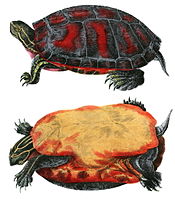
Pseudemys is a genus of large, herbivorous, freshwater turtles of the eastern United States and adjacent northeast Mexico. They are often referred to as cooters, which stems from kuta, the word for turtle in the Bambara and Malinké languages, brought to America by enslaved people from Africa.
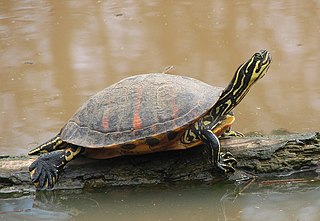
The Florida red-bellied cooter or Florida redbelly turtle is a species of turtle in the family Emydidae.

The eastern long-necked turtle is an east Australian species of snake-necked turtle that inhabits a wide variety of water bodies and is an opportunistic feeder. It is a side-necked turtle (Pleurodira), meaning that it bends its head sideways into its shell rather than pulling it directly back.

The Alabama red-bellied cooter or Alabama red-bellied turtle, is native to Alabama. It belongs to the turtle family Emydidae, the pond turtles. It is the official reptile of the state of Alabama.

The wattle-necked softshell turtle, also commonly known as Steindachner's soft-shelled turtle, is an endangered Asian species of softshell turtle in the family Trionychidae. The species is the only member of the genus Palea.

The Texas river cooter is a species of freshwater turtle endemic to the U.S. state of Texas. It is found in the river basins of the Brazos, San Bernard, Colorado, Guadalupe, San Antonio, Nueces, and their tributaries. It is one of three species of cooters (Pseudemys) occurring in Texas, including the Rio Grande cooter and the river cooter.
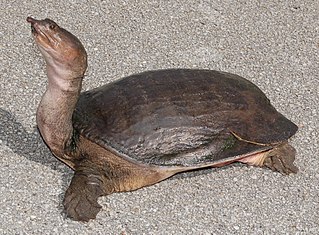
The Florida softshell turtle is a species of turtle in the family Trionychidae. The species is native to the Southeastern United States.

The river cooter is a species of freshwater turtle in the family Emydidae. The species is native to the central and eastern United States, but has been introduced into parts of California, Washington, and British Columbia.
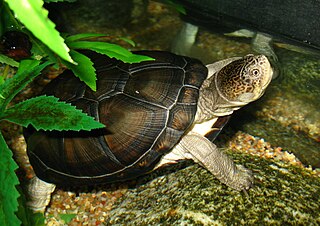
Pelusios is a genus of African side-necked turtles. With 17 described species, it is one of the most diverse genera of the turtle order (Testudines).

The Cumberland slider, also called commonly the Cumberland turtle and Troost's turtle, is a subspecies of pond slider, a semiaquatic turtle in the family Emydidae. The subspecies is indigenous to the Southeastern United States.

The Bellinger River turtle is a species of turtle in the family Chelidae. The species is of moderate size, with a straight-line carapace length to 240 mm (9.4 in) in females, and 185 mm (7.3 in) in males. It is endemic to Australia with a highly restricted distribution to the small coastal drainage of the Bellinger River in New South Wales. In the past the species was considered locally abundant. The species' preferred habitat is the deeper pools of the clear-water upstream reaches of the river, where water flows continuously in most months over a bedrock basement and a stream bed of boulders, pebbles, and gravel. A captive breeding program has been under way since a 2015 virus outbreak came close to wiping out the entire species. Most remaining individuals are currently housed in quarantine, though a small number have been reintroduced to the original habitat.

The Rio Grande cooter is a species of turtle in the family Emydidae. The species is native to northeastern Mexico and the adjacent southwestern United States.

The northern red-bellied turtle or American red-bellied turtle is a species of turtle in the Pseudemys (cooter) genus of the family Emydidae.

The eastern river cooter is a subspecies of turtle native to the eastern United States, with a smaller population in the midwest. It is found in freshwater habitats such as rivers, lakes, and ponds.
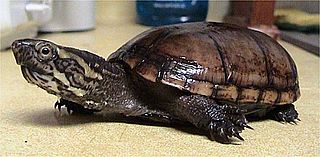
The eastern mud turtle or common mud turtle is a common species of turtle in the family Kinosternidae. The species is endemic to the United States. There are two recognized subspecies.
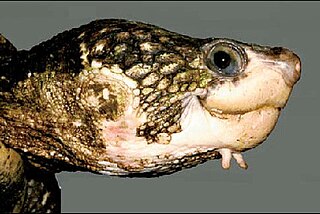
Elseya albagula, commonly known as the white-throated snapping turtle, is one of the largest species of chelid turtles in the world, growing to about 45 cm (18 in) carapace length.
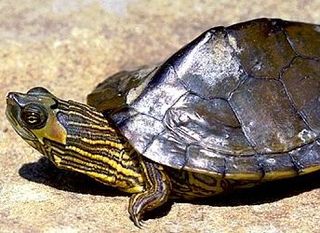
The Alabama map turtle is a species of emydid turtle endemic to the southern United States. Differentiation from other turtle species includes a black stripe running down the center of its back with knobs extruding from it, but these projections wear down with age. T.H. Bean and L. Kumlen first collected the Alabama map turtle in July 1876 from a lake near Montgomery, Alabama. Type locality for this species is Montgomery County, Alabama. Baur described and named the Alabama map turtle in 1893. The genus Graptemys includes nine species of mostly aquatic turtles.

The peninsula cooter is a species of freshwater turtle in the genus Pseudemys. It is sometimes considered a subspecies of the coastal plain cooter when that turtle is not itself considered a subspecies of the river cooter.

The Nicaraguan slider is a subspecies of turtle in the family Emydidae. The species is indigenous to Nicaragua and Costa Rica.

The Suwannee cooter is a subspecies of turtle in the genus Pseudemys. It is a subspecies of the river cooter. The species is endemic to Florida, including in the Suwannee River.
























